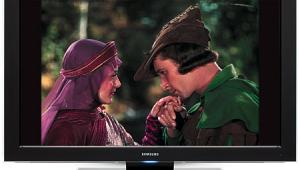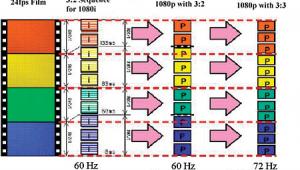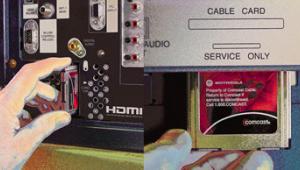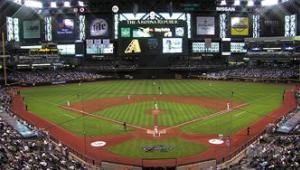So...What’s an OLED?
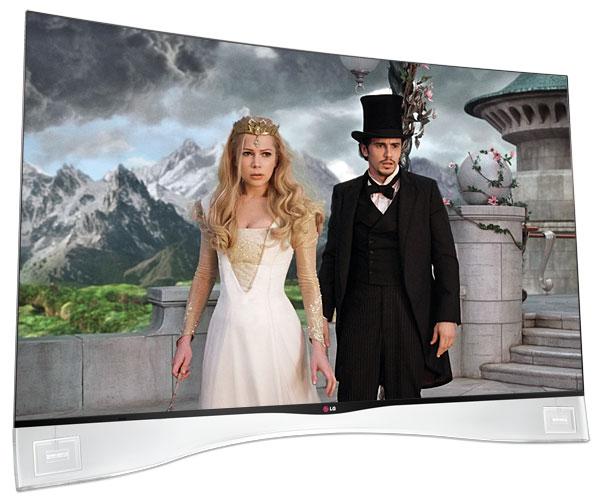
OLED holds the promise of truly infinite contrast ratios (and therefore a more realistic picture), incredibly fast response times, excellent energy efficiency, thinner panels, and in the long run, wall-sized TVs brighter and better than any projector.
How is OLED different? How can it be such a Holy RGB Grail of TV tech? I’m glad you asked.
Making Light
To understand what makes OLED different, first we need to discuss how plasmas and LCDs work. All TVs have millions of tiny picture elements or pixels. With a 1920 x 1080 (1080p) display, 2,073,600 pixels give you all your high-def glory.
In a plasma TV, each pixel is actually three tiny buckets. These buckets (with the open part facing you) are lined with a phosphor. This phosphor glows a specific color when energized by ultraviolet light.
With me so far? A bucket full of stuff that glows. Yep, this is how TVs work.
Also in the bucket is a noble gas (like xenon or neon). When this gas is excited by some electricity, it turns into plasma. When it turns into a plasma, a bunch of UV light gets released. That UV light makes the phosphor glow and pow, you’ve got a visible pixel! This is absolutely as weird and convoluted as it sounds.
To make a full color display, all you need are the three primary colors: red, green, and blue. If you’re guessing that the three buckets in each pixel (called subpixels) are lined with red, green, and blue phosphors, you’d be correct.
This method for creating an image has several benefits. The most important for us is the potential for incredible contrast ratios. Years of improvements in bucket efficiency, phosphor efficiency, and glass filter design has led to an “off” pixel that can be almost completely black, while an “on” pixel can be exceptionally bright. Until now, the only digital video technology that arguably had a better native contrast ratio was LCOS (a projector technology).
On the negative side, this blast-and-glow method isn’t terribly energy efficient (though plasmas have gotten a lot better). Also, because the phosphors don’t love to go dark instantly, there’s the chance of image retention (the temporary precursor to burn-in—or even permanent burn-in if the panel is carelessly treated to hours of a bright, stationary image).

LCDs, or Liquid Crystal Displays, work very differently. All LCDs have a backlight that creates the light you see. These days, this backlight is usually a series of LEDs, or light-emitting diodes (slightly different from OLED, but we’ll get to that later) residing in the edges or bezel of the TV. Rarely, these LEDs are spread across the back of the TV (a full-array backlight). Older LCDs and today’s most inexpensive LCDs, use cold-cathode fluorescent lamps (CCFLs) instead of LEDs. An important point here, though, is that it’s the panel of LCD pixels that actually produces the picture, not the LED backlight, which only responds to the incoming signal with varying intensity. There is no such thing as a consumer TV that uses LEDs as the pixels or picture-generating elements themselves—not even those sets advertised and labeled as LED TVs.
Just how those liquid crystals operate can seem a bit magical. Regardless of how or where the TV’s backlight is, the light is polarized (like sunglasses); essentially, all the photons are forced to march in the same direction. This polarized light hits the liquid crystal layer, and then something funky happens. With most LCDs, if a pixel is supposed to be on, this polarized light passes unmolested through an additional polarized layer and out to your eyeballs. If the pixel is supposed to be dark, the liquid crystal twists the light, so that second polarized layer blocks that light.
There are variations of this, where the “on” pixel is the one that twists, and many variations of how it twists, but the results are all the same. To create color, each pixel is really three subpixels, created with—you guessed it—a red, green, or blue color filter on top. Sharp Quattron LCDs add a fourth subpixel with a yellow color filter.
The benefits to LCD’s method of creating an image are better energy efficiency (LEDs use comparably very little energy), potentially extreme light outputs (it has a separate backlight, after all), and manufacturing that allows a much greater range of sizes compared with plasma.
The downsides are a lower contrast ratio compared with plasma (some light always leaks out), visible changes in the image when you’re not viewing the TV straight on, and a blurring of anything in motion. Most of the picture quality advancements in LCDs over the past few years have been aimed at improving contrast ratio (largely by using a technique called local dimming) and motion blur (higher refresh rates).
Which brings us to OLED. OLED is a material, always a mixture of carbon (hence, organic) and other chemicals, that glows at a certain wavelength when given electricity. These have fun names like “tris(8-hydroxyquinolinato)aluminium.” There are red, green, and blue (and other color) OLEDs, so we can make our TV image directly. So right off the bat, OLED has a simpler (i.e., more efficient) way to make light. Instead of igniting gas, which then makes a phosphor glow, or making an LED glow and blocking that light with polarizers and color filters, we can give an OLED pixel some power and it just makes light.
The benefits of this go far beyond on-paper efficiency. It’s not just that each pixel creates its own light, it’s that it can also not create light. Remove the power source from an OLED pixel, and it’s black. For the first time, that means a truly infinite contrast ratio. The videophile’s quixotic quest for inky-black blacks? Done. OLED does that. Even plasmas, as good as they’ve gotten, still emit a tiny bit of light when the pixel is supposed to be “off.”
RGB vs. WRGB
There are two flavors of OLED right now. Don’t worry, this isn’t a format war, more just different ways of making an OLED TV. Both sides claim their method is better, but both have strengths and weaknesses.

LG’s 55EA9800 uses what’s called WRGB. As its name implies, there is an additional subpixel. There’s no such thing as a white OLED. White light is a combination of all light, and no single OLED material creates all light. But it is still technically white, which is where things get interesting.
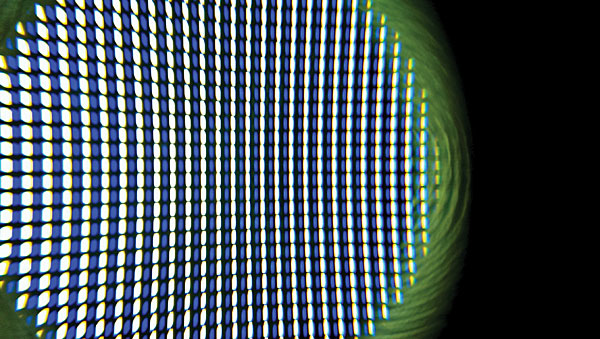
Every subpixel in a WRGB OLED is actually a layered sandwich of red, green, and blue OLEDs. Because of how OLED works, each layer can shine through the next layer, so the result is white light made of red, green, and blue wavelengths. Each red, green, and blue subpixel has a color filter on top to limit its output to that specific color. The white subpixel has no color filter and shines white. It’s there primarily to boost the light output.
While this seems weird (creating white then stripping out the color that’s already been created), LG claims several benefits. From a manufacturing standpoint, it’s potentially easier to manufacture (all the OLED subpixels are the same). Also, they claim that with each subpixel having all three colored OLEDs, they prolong lifespan—one color doesn’t age faster than another; they all age at the same rate.
Samsung’s RGB method is more traditional: it uses separate red, green, and blue OLED subpixels. RGB OLED is rumored to be more difficult to manufacture and potentially holds a greater chance for faster aging on the historically fragile blue OLED material. But this method doesn’t have WRGB’s potential for poor off-axis viewing that’s introduced by the use of the color filters. It also has the potential to be slightly more efficient given the lack of color filters that otherwise block much of the light created.

The manufacturing methods were described to me like this: LG’s is like painting a wall with a roller brush: fairly easy, lots of coverage. Samsung’s method is like painting a screen door with a toothpick: It has to be very precise. Will we see one method win out? Both? Who cares? It’s too early to tell if one method is better than the other, and since both are incredible to look at, the method behind them is largely pedantic at this point.
Not So Fast
We’ve now had a chance to see OLED TVs in person and test them out, and a few things are interesting in these first models. What’s interesting is that they’re not perfect.
Despite the promise of fast response times, both the LG and Samsung OLEDs have motion blur. This is because of how they drive their OLEDs, a process called “sample and hold.” With each refresh of the panel, the image is held for a few milliseconds, then, when the time comes, the image switches to the next frame. This is how nearly all LCDs work.
The problem is, your eye expects to see movement in those few milliseconds, and when it doesn’t, your brain blurs the image... seriously. The main way LCDs combat this problem is with faster refresh rates (120 hertz, 240 Hz, etc., instead of the 60-Hz frame rate native to video) and interpolated frames added between each original frame. Show your brain additional images, and the perceived motion blur disappears. Another, less popular, method is to insert a black frame in between the real images. This black image sort of clears your brain out a bit and is more reminiscent of how CRTs worked (with part of the image disappearing because the beam wasn’t hitting that part of the screen). The problem with this method, called black frame insertion, is that it noticeably reduces light output and can cause flicker.
Both LG and Samsung have both these methods available in their OLEDs. Thankfully, because OLEDs are very bright, the loss in brightness due to black frame insertion isn’t a huge deal and can be largely compensated for. Adding additional frames is also pretty easy these days, but frame interpolation can cause the dreaded soap opera effect, where movies and TV dramas can have the video-like smoothness of soap operas. Many people (including yours truly) hate SOE. I haven’t had a chance to test the LG’s black frame insertion, but I have checked the Samsung’s, and with it on, the TV could still be made very bright, and the motion detail was excellent. So while it’s disappointing that these early OLEDs can have motion blur, in practice it’s less of an issue than it first appears.
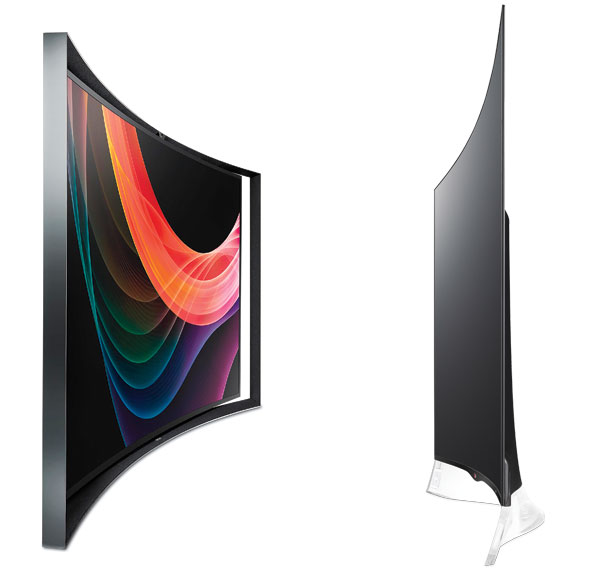
Energy consumption is also higher than we initially expected. It’s slightly higher than LED LCD, more similar to plasma. LG hasn’t published its specs yet, but Samsung’s estimate (according to the Energy Guide label) is that the KN55S9C will cost $27 a year to run, the same as its 60-inch F8500 plasma and slightly higher than its 55-inch F8000 LED LCD ($14). However, because of how OLED works, if you turn the overall light output down, it will draw less power. Also, it’s $27 a year, so I’m quite sure I don’t care. They’ll get more efficient as the technology advances.
Then there’s the problems that have dogged OLED production from the beginning and kept them off the market so long until now: pixel lifespan and manufacturing yields. The blue OLED material, specifically, has been an issue in early prototypes, aging and losing light output far more quickly than green and red. Over time, this would typically result in a yellowing shift as the TV aged. Newer materials have extended the blue lifespan considerably, which is one reason we’re finally seeing OLED TVs now. Neither LG nor Samsung is talking about their product’s lifespan, though, so we shall see.
The yields are another problem. In order for any technology to be truly profitable, you have to be able to manufacture it efficiently and sell nearly every unit that comes off the production line. Seems a simple consideration, right? The problem with some new technologies, and this includes OLED panels, is that some of the units coming off the line just don’t work. These you have to toss, seriously cutting into your profit margins. As recently as late last year, industry research reports suggested that as much as 70 percent of OLED panels being produced were unusable. Low yields like this would partially explain why the first OLEDs are $15,000 (LG) and $9,000 (Samsung). That will certainly come down. After all, the first plasmas cost $15,000 and they were 42 inches, not HD, and suuuuuuccccckkkked (my professional summation).
Infinity and Beyond
Because of how OLEDs create light, they’re potentially easy to scale up in size and resolution. A 110-inch, 4K OLED could be built using the same basic pixel size as the current 55-inch (more or less). Make the pixels larger, and you can go even bigger. Smaller, and you’ll increase the resolution. It’s not quite that simple, but as OLED gets even more efficient, smaller pixels can create the same amount of light (with higher resolution), and as manufacturing efficiencies improve, larger pixels are possible (to create larger displays). Want a wall-sized screen, mere millimeters thick, that’s brighter and better than any projector ever?
Already there are prototype flexible OLEDs. Roll up your tablet like a newspaper? Curve a display around your wrist like Turanga Leela? Yes, please.
There’s also been some progress with manufacturing methods that work essentially like ink-jet printers. How about every wall in your house as a display, showing art, a view from any location in the world (or beyond), or anything else you want, all for what you would have paid for paint, all running on less power than the light bulbs in your house now. If this sounds like sci-fi, it’s because it is. You’ve seen it before in countless movies, like Arnold’s Total Recall. But that’s the promise of OLED.
Who, What, Where, When
Right now, there are two companies selling OLED televisions in the U.S. consumer market: LG and Samsung. Both are 55 inches and curved. Though the companies claim certain benefits of immersion with a curved screen, the benefits are dubious. However, curved TVs certainly look cool and unlike anything else. Perhaps LG and Samsung figured they couldn’t sell OLED based on picture quality alone? They’d be right in that regard. In the history of televisions, the best-looking TVs rarely, if ever, light up the sales charts (remember Kuro?).
Panasonic and Sony announced a partnership and showed a 56-inch Ultra HD 4K OLED at CES 2013. So far, there have been no further announcements. Sony also sells a line of don’t-ask-how-much professional OLED monitors, and of course, was actually the first to market with an OLED TV in 2008: a $2,500, 11-inch desktop model that was gorgeous but obviously not a serious television.
There are also a few other companies that make OLED screens for portable products (phones, handheld games, etc.). OLED is fantastic in this use as well, given that it’s bright, thin, and energy efficient. Will some of these companies scale up to TV size? We shall see.
255 to 0 (Fade to Black)
The potential for greatness is certainly inherent in OLED technology. The reality is always different. The reality is, this is a new technology, and all new technologies have growing pains. The reality is, it’s going to be a few years before us mortals can afford OLED. The reality is, we’re on the cusp of a revolution, with OLED leading us into a flat and gorgeous future.




